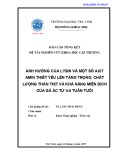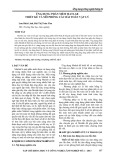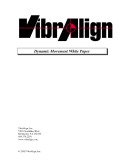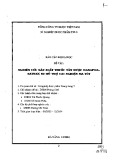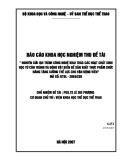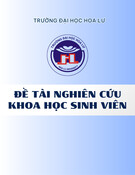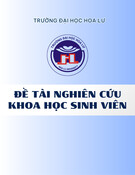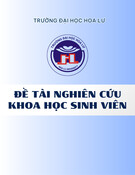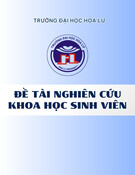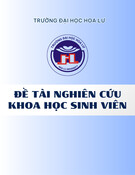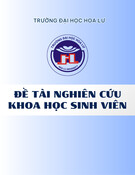
Interspecific
competition
between
Drosophila
melanogaster
and
Drosophila
simulans:
temperature
effect
on
competitive
ability
and
fitness
components
Catherine
MONTCHAMP-MOREAU
Laboratoire
de
Génétique
des
Populations
*,
Université
Paris
VII,
2,
place
Jussieu,
F
75005
Paris
Summary
Previous
studies
of
laboratory
and
natural
populations
suggest
that
Drosophila
simulans
is
much
more
restricted
in
its
tolerance
to
different
temperatures
than
its
sibling
species
Drosophila
melanogaster.
We
have
studied
competition
between
these
two
species
in
population
cages
at
20
°C,
the
optimal
temperature
for
D.
simulans,
and
at
25
°C
which
seems
to
be
more
favourable
to
D.
melanogaster.
At
25
°C
D.
melanogaster
eliminated
D.
simulans,
but
at
20
°C,
the
reverse
occured.
The
temperature
effect,
on
each
of
the
three
fitness
components
(fertility,
larval
viability
and
developmental
time)
measured
in
both
species,
in
the
experimental
conditions
of
the
cages,
is
in
agreement
with
the
observed
outcome
of
interspecific
competition.
Key-words :
Drosophila
melanogaster,
Drosophila
simulans,
interspecific
competition,
temperature.
Résumé
Compétition
entre
Drosophila
melanogaster
et
Drosophila
simulans :
Effet
de
la
température
sur
leur
compétitivité
et
sur
diverses
composantes
de
la
valeur
adaptative
Les
données
accumulées
à
ce
jour,
tant
en
laboratoire
que
dans
la
nature,
montrent
que
la
zone
de
tolérance
thermique
de
D.
simulans
est
beaucoup
plus
étroite
que
celle
de
son
espèce
jumelle
D.
melanogaster.
Nous
avons
donc
décidé
d’étudier
la
compétition
entre
ces
deux
espèces
dans
des
cages
à
population
placées
à
des
températures
différentes :
d’une
part
à
20 °C
qui
est
l’optimum
thermique
de
D.
simulans,
d’autre
part
à
25 °C,
température
qui
apparaît
plus
favorable
à
D.
melanogaster
qu’à
D.
simulans.
A
25 °C,
D.
melanogaster
élimina
D.
simulans,
mais
à
20 °C
l’inverse
se
produisit.
Trois
composantes
de
la
valeur
adaptative
(fertilité,
viabilité
larvaire,
temps
de
développement)
ont
été
mesurées
sur
les
populations
des
cages;
les
modifications
de
chacune
de
ces
trois
composantes,
lorsque
l’on
passe
de
20
°C
à
25 °C,
sont
en
accord
avec
le
résultat
de
la
compétition
interspécifique.
Mots-clés :
Drosophila
melanogaster,
Drosophila
simulans,
compétition
interspécifique,
température.
I.
Introduction
Temperature
is
one
of
the
main
ecological
factors
used
to
explain
the
differences
between
geographical
and
temporal
distribution
in
nature
of
the
two
sibling
species
D.
melanogaster
and
D.
simulans.
Despite
some
differences
between
strains
of
the
same
species,
due
to
their
geographical
origins,
D.
simulans
is
much
more
restricted
in
its
tolerance
to
temperature
than
is
D.
melanogaster.
In
the
laboratory,
D.
melanogaster
has
a
physiological
optimum
at
21
°C
(DAVID
&
CL
A
VEL,
1966;
1967),
but
grows
well
within
a
large
range
of
temperature
(from
15 °C
to
29.5
°C).
On
the
other
hand,
D. simulans
only
grows
well
(*)
E.R.A.
n°406
du
C.N.R.S. :
«Analyse
et
mécanismes
de
maintien
du
polymorphisme».

around
20 °C
(H
OSGOOD
&
PARSONS,
1966).
Mc KENZI
E
(1978)
showed
that
maximum
fecundity
occured
for
D.
simulans
at
20 °C
and
it
was
only
at
this
temperature
that
D.
simulans
was
found
to
be
superior
to
D.
melanogaster,
the
fecundity
of
which
remained
at
an
optimum
between
15 °C
and
25
°C.
Similar
results
were
obtained
for
the
emergence
percentage
(Mc
KENZIE,
1978;
TA
NTAW
Y
&
M
ALLAH
,
1961),
and
longevity
(PARSONS,
1977;
1978).
These
observations
are
in
accordance
with
most
of
the
geographical
and
seasonal
distributions
of
these
species:
D.
simulans
outnumbers
D.
melanogaster
in
the
regions
where
temperature
fluctuations
are
small
(PARSONS,
1975;
ROCH
A
-P
ITE
,
1980;
K
AWAN
ISHI
&
WAT
ANA
BE,
1977).
Paradoxically,
most
competition
experiments
and
fitness
measurements
of
these
two
species
have
only
been
carried
out
at
25 °C.
At
this
temperature,
in
population
cages,
when
wild
strains
are
used,
D.
melanogaster
eliminated
D.
simulans.
Yet,
opposite
results
were
observed
with
mutant
strains
(GOLDSTEIN
&
TEISSIER,
1953)
or
with
strains
selected
for
their
competitive
ability
(PARSONS,
1975
for
a
review;
HE!tttcx
&
M
URRAY
,
1980).
By
contrast,
MoottE
(1952),
then
TANTAWY
&
SOLIMAN
(1967)
showed
that
at
15 °C
D.
simulans
rapidly
outnumbered
D.
melanogaster,
although
the
latter
species
was
not
eliminated
when
the
experiment
stopped.
As
the
optimal
temperature
for
D.
simulans
is
near
20 °C,
it
was
of
interest
(suggested
by
PARSONS,
1975)
to
study
competition
between
the
two
species
at
this
temperature.
This
paper
first
presents
the
results
of
the
competition
in
population
cages
at
20 °C
and
25
°C.
In
addition
to
observing
changes
in
the
frequencies
of
the
two
species
at
these
temperatures,
observations
were
also
made
on
three
fitness
components,
namely
fertility,
larval
viability
and
developmental
time,
measured
in
the
experimental
conditions
of
the
cages.
II.
Materials
and
Methods
A.
Populations
in
competition
The
two
french
wild
strains
used
in
this
study,
D.
melanogaster
Chevreuse
(mel
+ )
and
D. simulans
Villeurbanne
(sim
+ ),
had
been
collected
in
the
wild
two
years
before
the
experiment
commenced.
Ten
population
cages
( 10
x
15 x 40
cm)
were
initiated
with
1000
adults
(500
males
and
500
females).
Five
cages
were
maintained
at
20 °C
and
five
at
25
°C.
At
20 °C,
the
initial
frequency
of
each
species
was
0.5.
At
25 °C
the
initial
frequencies
were
0.2
for
D.
melanogaster
and
0.8
for
D.
simulans,
to
avoid
the
too
rapid
elimination
of
the
latter
species.
At
both
20 °C
and
25
°C,
two
cages
contained
only
the
wild
strains
of
the
two
species.
In
the
other
three
cages,
different
morphological
polymorphisms
were
introduced,
namely
vermilion
(v),
sepia
(se)
and
cinnabar
(cn),
in
order
to
observe
the
effect
of
these
polymorphisms
on
the
interspecific
competition.
The
mutant
stocks
used
had been
kept
under
laboratory
conditions
for
many
years.
The
composition
of
the
cages
and
the
system
used
to
designate
them
is
summarized
in
Table
1.
The
initial
frequency
of
the
mutants
was
0.8.
The
populations
were
maintained
in
overlapping
generations
by
supplying
each
cage
with
two
cups
of
fresh
medium
(PEARL
et
al.,
1926)
every
two
days.
The
cages
at
20 °C
contained
24
cups
and
each
cup
stayed
in
the
cage
for
24
days.
The
cages
at
25
°C
contained
18
cups,
each
of
them
remaining
there
18
days.
Under
these
experimental
conditions
there
was
strong
competition
among
the
larvae
for
food.
The
number
of
adults
in
the
cages
averaged
2000
over
the
period
of
the
observation.
At
20 °C,
this
number
was
very
stable
but
at
25
°C,
great
fluctuations
occured.

Changes
in
the
relative
frequencies
of
the
two
species
were
measured
by
periodic
egg
samples.
Two
food
cups
were
placed
in
each
cage
and
left
for
24
hours.
They
were
then
allowed
to
develop
without
any
additional
supply
of
medium
so
that
larval
competition
was
the
same
as
in
the
cages.
When
adults
emerged,
the
males
(between
100
to
150)
were
all
classified
and
counted.
B.
Fitness
components
Three
components
of
fitness
were
measured,
fertility,
larval
viability
and
time
of
development.
These
are
known
to
show
great
variation,
depending
on
environmental
conditions,
in
particular
larval
density,
adult
number
and
species
frequencies
(PARSONS,
1975
for
a
review).
Consequently,
these
measurements
were
made
directly
on
the
cages
flies
in
order
to
reflect
as
exactly
as
possible
what
occurred
during
evolution
of
the
populations.
Fertility
and
developmental
time
were
measured
only
in
the
cages
containing
wild
populations,
and
larval
viability
in
all
cages.
1)
Fertility
Fertility
at
20
°C
was
measured
in
cage
S’1,
and
fertility
at
25
°C
in
cage
M’1.
A
sample
of
about
200
adults
was
taken
from
the
cages,
at
four
different
times
(samples
1
to
4).
Each
female
was
put
into
a
vial
with
20
ml
of
medium
so
that
the
surface
avaible
for
oviposition
was
the
same
as
that
in
the
cages,
but
there
was
no
competition
for
food
among
the
larvae.
The
females
were
allowed
to
lay
eggs
for
24
hours
and
then
they
were
put
back
into
the
cages.
The
adults
that
emerged
were
all
counted
and
their
species
determined.
The
fertility
of
each
species
was
measured
as
the
mean
number
of
offspring
produced
by
one
productive
female.
2)
Larval
to
adult
viability
Three
cups
of
food
were
periodically
introduced
into
each
cage.
Two
of
them
were
allowed
to
develop
without
any
new
supply
of
medium,
so
that
larval
competition
for
food
was
the
same
as
in
the
cages
(crowded
series :
CS).
The
third
cup
was
evenly
distributed
between
two
bottles
with
a
supply
of
food,
in
order
to
reduce
larval
competition
(uncrowded
series :
USC).
The
differences
in
the
frequencies
of
adults
of
each
species
emerging
from
these
two
series
(CS
and
UCS)
were
due
to
larval
competition.
3)
Developmental
time
Two
cups
of
food
were
introduced
into
the
cages
for
24
hours.
They
were
then
removed
and
each
day
the
number
of
emerging
males
was
counted.

III.
Results
and
Discussion
A.
Population
evolution
Changes
in
the
frequencies
of
D. simulans
in
each
of
the
ten
cages
are
shown
in
Fig.
1.
At
25
°C,
D. simulans
was
eliminated
by
D.
melanogaster
in
all
five
cages;
a
result
which
agrees
with
previous
findings.
At
20
°C
the
opposite
result
occurred
with
D.
melanogaster
always
being
eliminated.
Introducing
homologous
mutants
(sepia
or
vermilion)
into
the
wild
strains
of
the
two
species
does
not
change
the
outcome
of
competition.
Each
of
these
mutations
certainly
had
a
similar
influence,
in
both
species,
on
the
competitive
ability
of
the
populations
into
which
it
has
been
introduced.
In
fact,
it
was
established
that
both
sepia
and
vermilion
genes
respectively
reached
the
same
stable
balance
with
the
wild
type
in
both
species
(MONTCHA
MP
-MO
REAU
,
1982).

The
elimination
rates
of
a
species
did
not
differ
greatly
between
the
two
identical
cages
of
wild
populations:
there
was
a
difference
of
19 days
for
D.
melanogaster
elimination
between
cages
Sl
and
S’l
and
a
difference
of
22 days
for
D.
simulans
elimination
between
cages
M1
and
M’I.
In
contrast,
comparison
of
elimination
rates
for
each
species
in
homologous
cages
at
20 °C
and.
25 °C
(Table
1 )
shows
that
these
rates
were
certainly
modulated
by
differences
in
competitive
ability
among
the
strains.
For
example,
the
wild/sepia
population
of
D.
simulans,
which
was
the
most
rapidly
eliminated
at
25
°C
(68
days),
was
the
slowest
to
eliminate
D.
melanogaster
at
20
°C
(267
days).
These
differences
in
competitive
ability
among
the
populations
of
the
cages
are
certainly
due
to
differences
in
the
genetic
background
of
the
mutant
strains.
B.
Fitness
components
1. Fertility
In
all
the
samples,
an
appreciable
proportion
of
females
produced
no
offspring
(unproductive
females).
The
frequencies
of
each
species
among
the
productive
females
are
not
significantly
different
from
the
frequencies
observed
for the
males
in
six
of
the
eight
samples
(Table
3).
In
the
two
samples
where
a
significant
difference
is
observed,
there
is
a
shortage
of
D. simulans
among
the
productive
females.
MOTH
(1974)
obtained
similar
results.
He
showed
that
when
adult
density
is
high,
the
percentage
of
unfertile
females
is
much
higher
in
D.
simulans
than
in
D.
melanogaster.
But
it
must
be
pointed
out
that
our
experimental
conditions
(isolated
females)
suppressed
the effect
of
intra
and
interspecific
competition
for
oviposition
sites,
which
seems
to
be
particularly
important
in
reducing
oviposition
in
D.
melanogaster
(Fu’rUYUta,
1970;
S
AMEOTO
&
MILLER,
1966).
Thus,
our
results
must
be
regarded
with
caution.
Results
for
productive
females
are
given
in
Table
4.
For
each
species
and
each
temperature,
mean
fertilities
are
significantly
different
in
the
four
samples,
except
for
D.
simulans
at
20 °C.
Such
changes
in
fertility
during
the
course
of
the
competition
might
be
due
to
environmental
fluctuations
and
to
variations
of
age
structure
in
the
adult
oooulation.

